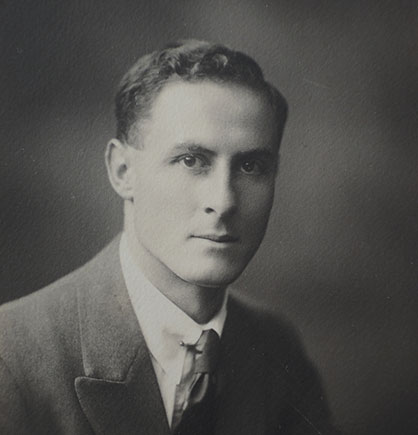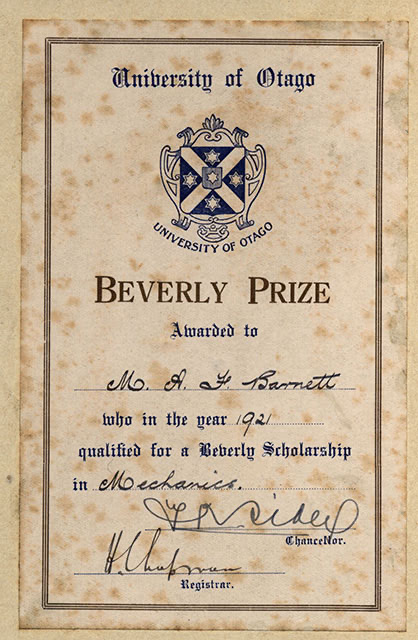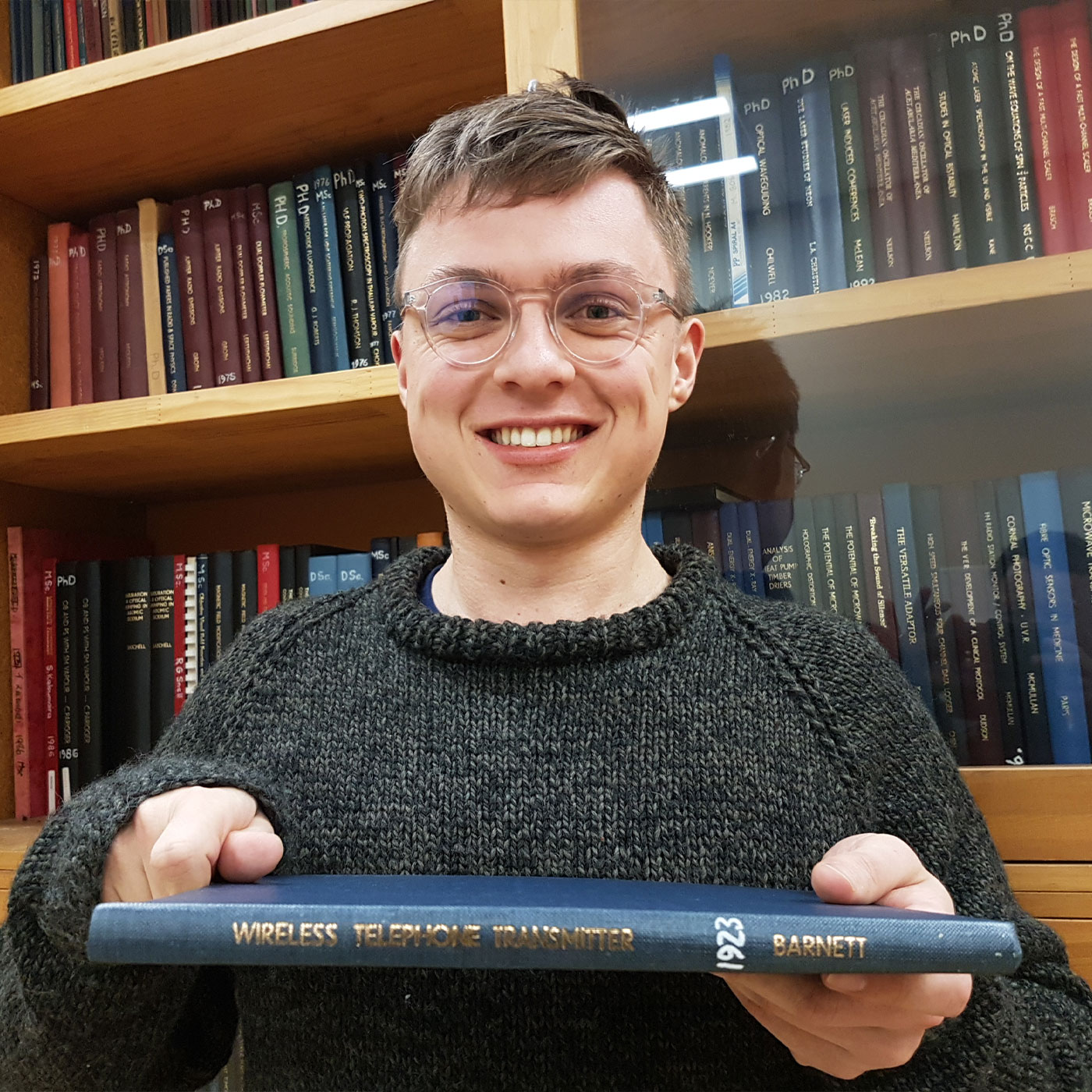One family:
generations of discovery
What are the odds? Two Beverly Scholarships in one family, one hundred years apart. That's a question that statistics honours student Conor Hassan might be able to solve, along with his great-grandfather, distinguished Otago physics and maths alumnus Miles (MAF) Barnett OBE.
Add to that the improbability of Conor recently discovering Miles' master's thesis in a cabinet in Otago's Department of Physics and the treasure chest of stories in a remarkable family history just keeps on growing.
When Conor Hassan came to Otago in 2017 from Christchurch he says he didn't know much about his great-grandfather, apart from the fact he had studied physics and maths at the University and that his family was from Dunedin, having come from England.
“I knew more about Miles' dad, Louis, my great-great grandfather. The Barnett lecture theatre at the hospital is named after him – he was one of the first surgeons in Dunedin.”

Miles Barnett taken when he was at the University of Cambridge.
That great-great grandfather is Sir Louis Barnett CMG, one of New Zealand's most renowned surgeons. Sir Louis attended Otago from 1883 to 1884, later attaining his MB, CM from the University of Edinburgh and was the first New Zealander to become a fellow of the Royal College of Surgeons of England.
After returning to Dunedin he become Professor of Surgery at Otago in 1909. He was instrumental in the establishment of the College of Surgeons of Australasia and a pioneer in hydatids' research. The Ralph Barnett Chair of Surgery at Otago is named in memory of his son who was killed in action in WWI.
This was a high achieving family. Sir Louis' other children were Geoffrey, also a surgeon and lecturer at Otago; Denis who was appointed an Air Chief Marshal with the RAF in the early 1960s and knighted KCB in 1957 and GCB in 1964; and Marjorie, who became deputy director of the nursing division of the Department of Health and was awarded an OBE in 1954.
Louis, Ralph and Geoffrey were all at Gallipoli.
Scholarships a century apart
When Conor first received the Beverly Scholarship in statistics and mathematics in 2019, he didn't realise that Miles had received it too – in 1920, 1921 and 1922 – until someone in the Physics Department told him.
“I've never really cared about awards, but perhaps the coolest thing about getting the Beverly Scholarship was that Miles got it 98 years ago.”
Conor, who has recently received the scholarship for the second time, says Miles “obviously did pretty well” and after Otago went off to the University of Cambridge in the UK to do his PhD.
Conor's uncle John Harte has been trying to track down Miles' work to fill in gaps in the family history, especially concerning the research Miles was doing before and after Cambridge.
As part of his research, he asked Conor if he'd like to try to find Miles' master's thesis. Conor admits he wasn't very optimistic about the possibility of it being there.
“I'm like how long ago, 1922? I'm not sure I'm going to have much luck. So I just went to the Physics Department and they asked if I knew what year it was, and I said 1920s sometime. Then we went and looked – and there it was. It was probably one of the oldest ones they had in the cabinet – a small hardbound book.
“He had all these hand-drawn diagrams. I'd heard about the work he'd done and it was pretty cool seeing something physical from so long ago.”
He said his uncle was “super-excited” at the find, which is actually the second-oldest thesis in the department's thesis cupboard, and all the family has learned something new about their relative.
Miles' thesis is entitled Analysis of Modulation in a Wireless Telephone Transmitter and analysed the operation of some of the equipment used by Otago's Professor Robert Jack in his experimental radio broadcasts of 1921 and 1922.
The current Beverly Professor of Physics at Otago, Craig Rodger, says Professor Jack was a pioneer in radio research in New Zealand, undertaking the first "wireless" broadcasts in this country using his equipment.
“The Physics Department was then located in the University Clocktower, putting it right at the heart of this piece of history,” he explains. “In some of his first broadcasts he asked listeners to telephone the University if they could hear his transmissions. Professor Jack was initially pleased when calls came in from the hill suburbs of Dunedin city, but later very surprised when telegrams arrived from other parts of the country to confirm they too could receive his signals.
“Miles was working alongside Professor Jack on this world leading research – preparing him for his next step into the world.”
From Cambridge to the Met Office
Miles graduated MSc with double first-class honours in physics and mathematics in 1924.

Miles Barnett's Beverly Prize certificate 1921.
At Cambridge he entered Clare College and studied in the Cavendish Laboratory where he was assigned by famous New Zealander Sir Ernest Rutherford to an investigation of the propagation of radio waves under the supervision of English physicist Edward Appleton.
Their experiments confirmed the existence of an electrically conducting layer in the upper atmosphere that could reflect radio waves beyond the curve of the earth, and also showed that at times the reflections could come from a second, higher layer. Their initial findings were published in Nature in 1925.
Professor Appleton was later knighted for his pioneering work in radiophysics and, in 1947, received the Nobel Prize for Physics – and is said to have mentioned Miles in his Nobel Lecture.
Miles was awarded his PhD in 1927 and elected a fellow of the Institute of Physics in 1929. After marrying, he returned to New Zealand, settling in Wellington where he and his wife Margaret (Peggy) raised three children. He worked as a physicist for the newly-established DSIR before being appointed to the New Zealand Meteorological Office in 1935 to develop the services needed for aviation, serving as director from 1939 to 1962.
During WWII, the Meteorological Office became a branch of the Royal New Zealand Air Force. Miles became a Wing Commander and, at the height of the war, had nearly 500 staff stationed from the equator to the sub-Antarctic islands.
Highly regarded for his judgement, tact, quiet guidance and setting of high standards, he was made an OBE in 1945, a fellow of the Royal Society of New Zealand in 1947, and Officer of the US Legion of Merit in 1948. He became the first vice-president of the World Meteorological Organisation (WMO) 1955-1959 and was a member of the executive committee 1959-1962. He was also chair of the National Committee for the International Geophysical Year in 1957-58. He died at Waikanae in 1979.
His daughter Jane, now living in Paraparaumu, remembers her father as a “modest and quiet man”.
“He took his time thinking things through at the weather office. At the WMO it was very much the East and West block and you voted for your block. Dad was known for thinking about what was said and would vote on the other side depending on what he thought was right. They couldn't rely on him to follow the pack.”
She says he was away a lot of the time for meetings to do with his work, including trips to the Antarctic and up to Norway and frequently in between. She has a photo of him at the South Pole.
“I think he was the most-travelled public servant during that time.”
'Pretty decent' at maths
Maths talent runs through each generation of the family – Conor's mother Trish Harte is a maths teacher and another of Conor's uncles, David, was a lecturer in statistics at Victoria University of Wellington, before moving to Statistics Research Associates.
“Everyone's pretty decent at maths,” says Conor. “People always said to me you're just going to go and do a maths degree and I was always like, no I'm not. But then I guess it just happened: you can't control things sometimes.”
His older brothers Papu and James also came to Otago and studied computer science and anthropology.
Last year Conor was awarded the Prime Minister's Scholarship for Asia and spent a semester studying stats and maths and assorted sciences at the National University of Singapore. Before starting his term there, he travelled in China for five weeks on a volunteer programme teaching English.
“It was just to see China a bit: you always hear so many stories about it. I went over by myself and I don't know Mandarin and didn't go to Shanghai or Beijing and people didn't speak English, so it was a bit touch-and-go sometimes, but it was fun, I enjoyed it.”
His honours research project is on the topical subject of modelling for fake news in elections and he says he definitely wants to go on to do a postgraduate degree afterwards.
“It would be kind of cool going overseas, but we'll have to see how that goes. It's a bit of a weird time.”
With the discovery of the thesis, Conor and his great-grandfather's story has also caught the interest of other academics at Otago, including Professor Craig Rodger, a fellow recipient of the Beverly Scholarship.
Like Miles, Professor Rodger works in radio and did his postdoctoral studies at Cambridge.
He says while he knew about the work in radio done by Professor Jack, he's enjoyed learning about MAF Barnett as this piece of his department's history has come back to light.
"Physics is one of the founding research areas at Otago University,” he says. "But we have not strongly focused on our history – discovering that Prof Bobby Jack worked with a student who went to Appleton in Cambridge and then did great things for New Zealand has been a new thrill for me. And now Conor: well, I suspect he's brilliant, just like his relative.”
MARGIE CLARK
Another great discovery - Conor Hassan with his great-grandfather Miles Barnett's MSc thesis.
